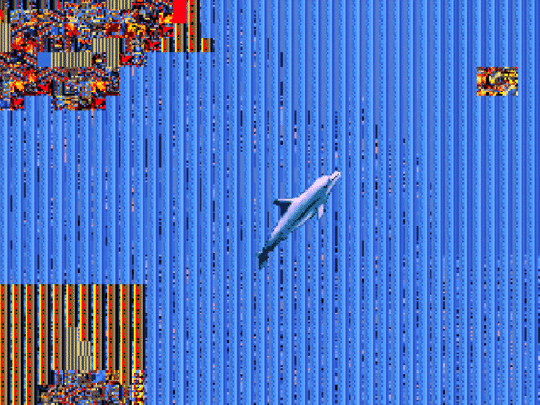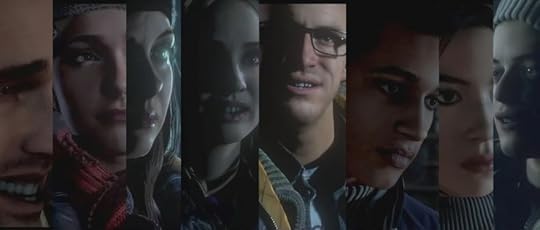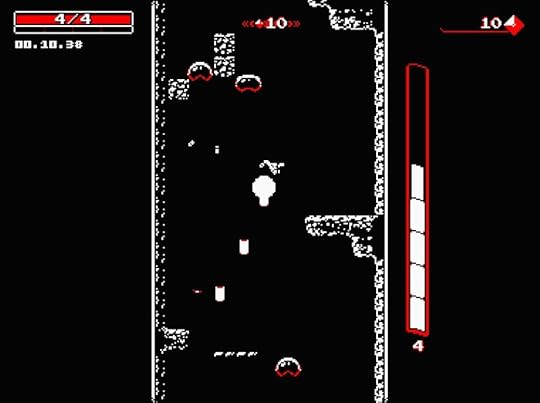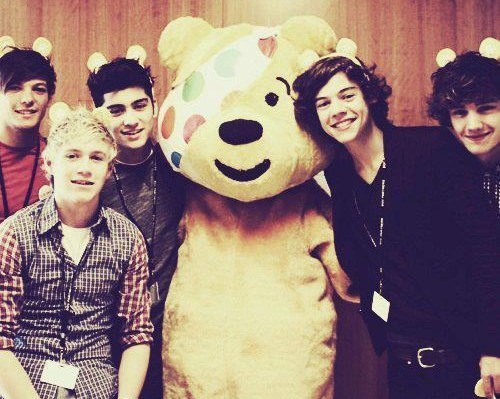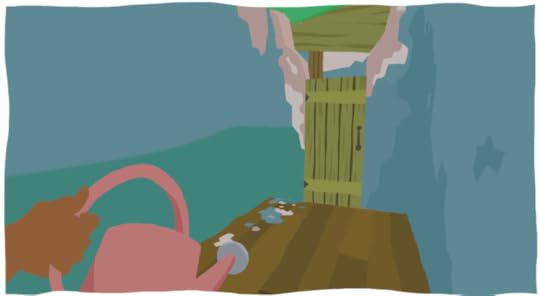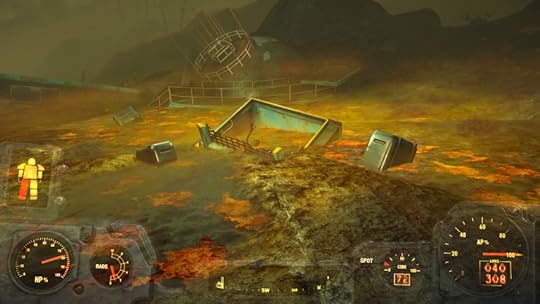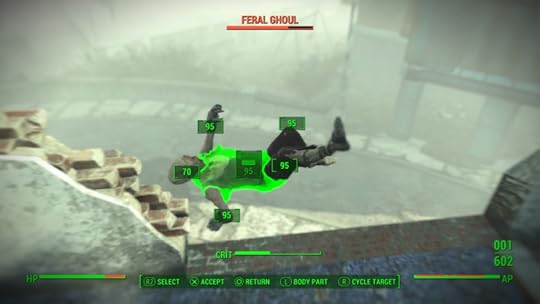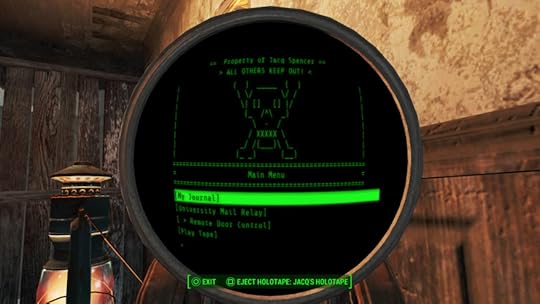Kill Screen Magazine's Blog, page 192
November 19, 2015
Push Me Pull You is the grossest couch co-op game, and I can’t wait
Delightfully repulsive couch co-op game Push Me Pull You is headed to PlayStation 4 and PC, Mac, and Linux early next year.
The game pits two teams of two players each in a literal head-to-head duel, where team members control their own side of a stretchy, noodle-like body conjoined at the midsection. Both players in a team have the power to extend and contract their side of the body at will, helping to coil, twist, and worm their way around an arena (and their opponent) for control of a ball.
It’s gross, hilarious, and unlike any other local multiplayer game I’ve played. The controls are fluid and the team dynamic is immediately apparent, but there’s a level of silliness that emerges from the awkward competition even outside the comical visuals and fleshy sound effects. It’s the shared disgust, confusion, and amusement between teammates and opponents, the improvised strategies that somehow form among the squirming mass of meat, the strange vocabulary that’s crafted mid-game for common patterns and formations. I still remember a few from my first encounter with this game during GDC 2014: The Slip. The Worm. The Snail.
“playing soccer with your small intestines”
The way Melbourne-based developer House House describes it is just as gag-inducing: “Push Me Pull You is a videogame about friendship and wrestling. Joined at the waist, you and your partner share a single worm-like body and must wrestle the other sports-monster for control of the ball. It’s a bit like a big hug, or playing soccer with your small intestines.”
Along with the PlayStation 4 announcement comes new info on additional game modes and arenas. One new mode, Knockout, adds two balls instead of just one, so players must work to keep their own ball in the arena while pushing their opponent’s out.
Push Me Pull You will be available to demo at PlayStation Experience in San Francisco on December 5 and 6.
Learn more about Push Me Pull You on its website.
Ecco the Dolphin glitch art is all your vaporwave dreams come true
All images created by and belong to Sabato Visconti.
///
In Sega’s absence, the 1992 undersea videogame Ecco the Dolphin has developed a perplexing life of its own. Back in 2010, musician Daniel Lopatin released a cassette tape limited to 100 copies that contained an album called “Chuck Person’s Eccojams Vol. 1.” Not only was Ecco‘s name in the title, but the tape’s artwork was a chopped-up image of the original game’s cover art (created by fantasy scene painter Boris Vallejo) as a tribute to it.
As to the cassette tape itself, it contained 14 unnamed tracks of slowed down, fragmented, and looped pop tracks. These are said to be “echo jams.” While the screwy micro-loops are jarring, beyond that the music’s glacially slow tempo in parts is somewhat narcotically profound in effect; hazy, meditative, perhaps even transcendental. It’s this that has become the foundations of an art movement known as “vaporwave.” The distorted audio remix and Ecco the Dolphin were a big part of the movement’s aesthetic inspirations.
a voidspace where Ecco can chill out forever
Writing about the Eccojam cassette and how it informed vaporwave, John Behm focuses on the track Eccojam A3, which samples the 2006 R&B track “Too Little Too Late” by JoJo. This is what Behm writes:
“Chuck Person takes the phrase “be real, it doesn’t matter anyway (you know it’s just a little too late)” and sets it looping over and over for three minutes. In its original context, that lyric means almost nothing: it comes off as more of a redundant filler lyric than anything. Yet, when repeated and slowed down to a point where it might even sound chanted, “be real, it doesn’t matter anyway” comes off as somewhat of a manifesto for the entire genre.”
What’s important to take away from this is that vaporwave uses data errors and glitches (such as tape slow-down in this case) to repurpose a commercial product and find new meaning within it that falls in line within its ethos. All this is to say that it it’s about time Ecco the Dolphin, the game itself, was purposefully fragmented and remixed with glitches in order to join the ranks of the movement it unknowingly lent itself to. And that’s exactly what Brazilian glitch artist Sabato Visconti has done with his latest series titled “エコー ザ ドルフィン Ride the C a t a c l y s m.”
Visconti has produced 15 gifs that see the the 1992 game held in suspended corruption. Frazzled tiles have taken over the coral and rocks while the remnant blue and purple hues are stretched or repeated in luxuriously smeared lines. Given that vaporwave mostly seems to enjoy the capacity of Ecco the Dolphin to let you eschew its goals and swim somewhat freely in its blue oceans if you choose (that’s how I remember playing it)—reaching a kind of meditative slump—it seems appropriate that most of these glitches see the dolphin hanging effortlessly, almost limp, comfortably numb in what was once water. There’s nothing of the original game left, only a voidspace where Ecco can chill out forever in a placid, non-resistant state of being.
Other gifs draw more focus on the game’s large crystals as glamorous icons (more in line with vaporwave’s “co-opting the icons of hi-def capitalism“) or see the dolphin multiplied and swimming in-and-out of the screen, further communicating the idea that there’s freedom in this glitch void. I could watch these looping gifs for hours, probably, musing on the the game’s lo-fi fragility. They make for an unsurprisingly good accompaniment to “Eccojams Vol. 1.”
You can see all of Visconti’s Ecco the Dolphin glitch art gifs on his website.
A creator of SOMA on the surprising merit of Until Dawn
Sometimes, a big budget game comes along that, despite an almost Duke Nukem Forever-esque level of development redos and challenges, finally reaches your videogame system only to impress rather than disappoint. It’s so rare that it almost feels like magic when it happens. But the question is: how come a game like Until Dawn—originally created for the PS3 and with the expressed intent of tricking you into believing Playstation Move wasn’t useless—transforms into a beautiful butterfly while games like Duke Nukem Forever turn into steaming piles of shit? It must be those fickle videogame gods at it again, arbitrarily deciding who goes to heaven and who is Duke Nukem Forever.
Of course that isn’t how it works. And sometimes you need a fellow videogame designer to dissect exactly what is responsible for the difference. Which is where Thomas Grip, creative director of Frictional Games (the makers of SOMA and Amnesia: The Dark Descent), comes into the picture. Recently, he investigated the surprising awesomeness of Supermassive’s Until Dawn.
it almost feels like magic when it happens
In an essay published on Frictional’s devblog, Grip dissects the design choices that make Until Dawn great, and explains how it could’ve failed if those moving parts didn’t work in tandem withe each other. Calling the game a B-movie horror that, through an admirable level of sincerity and finesse, manages to be “the best B-movie possible,” Grip notes how Until Dawn knocks it out of the park tonally because it “takes itself just seriously enough for you to overlook the sillier aspects yet still feel emotionally invested in the fates of the characters.” (Something which, by comparison, might’ve saved a game like Duke Nukem Forever.)
But despite its excellent narrative setup, Until Dawn still had the infamous “interactive movie” genre to help it fail miserably. Yet while creators like David Cage have spent almost their entire career making an argument against the interactive movie, Until Dawn implements small mechanics that show a path forward for an otherwise uninteresting conceit.
Grip largely attributes Until Dawn‘s success to the Multiple Deaths System. A huge amount of the tension derives from a few devices that make the player feel like each of the eight characters she controls could die at any moment if she misses a button press or acts too rashly. Multiple Deaths Systems aren’t new to the interactive movie. But, by contrast, titles like Heavy Rain relegate the life-or-death moments to a few scenes while Until Dawn keeps it alive throughout every second of the game.
While Grip admits that branching narrative games like Telltale have largely begun to wear on him, Until Dawn switches the metagame of the decision-making mechanic just enough to make it engaging again. Since branching narratives usually collapse quickly, ” your choices are more about pondering the decision, and less about the outcome.” Meanwhile in Until Dawn, even the minor Quick Time Events feel like a life or death situation, weighing down mere button presses with dire consequences. As Grip points out, it’s a system that’s “close to optimal for a horror game” where characters are expendable.
Another stroke of brilliance lies in Until Dawn‘s collectibles. Instead of being fluff, the totems scattered around the game—which give brief glimpses into possible outcomes for characters—are not only narratively-sound, but also integral to making the player feel like a proactive agent rather than a reactive pawn in a narrative they don’t control. “This forecasting gives the game a certain sense of strategy and forces you to consider current events more carefully,” as the player tries to guess plot-points which in turn complicates her decision-making process.
“The ability to make plans is part of what it means to be human,” he explains, “and there are good reasons to think it’s one of the biggest reasons for us developing a consciousness.” Games naturally tap into that human impulse. But often times narrative games struggle to maintain the illusion, and end up feeling like the player is merely along for the ride. Until Dawn also rewards players for paying attention to its story. Since “knowledge of the game’s lore can help you survive situations,” you’re rewarded more control the more you explore the world.
“The ability to make plans is part of what it means to be human”
Finally, Grip attributes the gorgeous environments in Until Dawn to the final trick up the developer’s sleeve. “You start up in the forest, then go to the swamps, then to the mountains and finally you arrive at the castle.” It’s what grip calls a “Super Mario way of location progression,” and keeps everything fresh and exciting.
Though Until Dawn is a great addition to the interactive movie genre, Grip also concedes that its biggest flaws are inherent to this style of game. There are still plenty of dead end choices and cutting corners in terms of impactful choices—not to mention that the glut of cutscenes can sometimes make a player feel like an observer rather than a participant.
But Until Dawn just goes to show how effective a few key design choices can be in making a game soar rather than flop. The magic we attribute to games design “lies in controlling the player’s mental model of the game. That is how they perceive the game’s virtual world to work, and what aspects that become most important in shaping how decisions are made and emotions evoked.”
While there are many issues with the narrative game format as a whole, “they keep pulling me back,” Grip says. Though some might claim the narrative game (or interactive movies) lacks a sense of playability, they also “lack the fluff that that is so common in other games. The uninspired shoot-out sections that are obviously just there to make the game longer.”
While these design issues continue to persist in games like Until Dawn and even arguably Frictional Games’ own SOMA, it’s clear that magic won’t be what solves it. Instead, it’ll be the inspired choices of a game’s creators. Because if this a design problem, then surely that also means there must be a design solution.
You can read the full essay here.
A Series of Gunshots calls out senseless gun violence in games
In the narrowest of senses, Pippin Barr’s A Series of Gunshots is a shoot ‘em up. All you do is fire a gun. The game has no other mechanics or activities. It is, however, the farthest thing possible from a traditional shoot ‘em up.
A Series of Gunshots is composed of a series of gunshots. Who’d have thought it? The game consists of a series of black and white scenes. No humans can be seen. Do they even exist in this world? Press a key—any key other than spacebar. A gun goes off. The shot is heard. A window in the distances goes from black to white, illuminated by the small explosion you just unleashed. Faster than you can say “what have I done?” the window goes black again and all you’re left with is the question. The world is as it always was, except you know that isn’t really true.
What have you done?
A Series of Gunshots is interested in that question above all else. The game, Pippin Barr writes, “is entirely focused on the question of gun violence in daily life and most especially its representation (and general glorification or enjoyment) in videogames.” The structure of A Series of Gunshots encourages this sort of reflection; there isn’t really much else to do so you might as well engage in some introspection. In case you’re not feeling reflective, the leisurely black screens between scenes offer sufficient time to catch up.
Whether A Series of Gunshots achieves its goal of being “a game that could make gun violence appear and feel as awful as it is in reality” is up for debate. The game does not glorify the gun even if it is central to its mechanics. (In fact, the gun is never visible.) I do, however, wonder if A Series of Gunshots would really persuade anyone who was on the fence about guns either in videogames or in society as a whole. A Series of Gunshots is a good game because of its subtlety, but the flipside of this is that it is not all that persuasive. What if, say, all the flashes in windows are people warding off attackers? That is not my reading of the game and I can’t say that I find it particularly plausible, but the game doesn’t preclude this reading. A Series of Gunshots is a relatively blank canvas onto which one can project feelings about gun-related incidents. This subtlety is laudable, though it leaves us roughly where we’ve always been: Groups with different feelings about gun violence can find validation by talking among themselves. To be fair, Pippin Barr’s factsheet concedes that the game is unlikely to be a decisive blow in any debate about guns: “It isn’t necessarily clear this game succeeds at it. But it is an attempt, and it is something that needs to be tried again and again.”
A Series of Gunshots is a blank canvas onto which you project feelings about guns.
We do need to try, and we need to try harder. Violence in videogames—and, more specifically, gun violence—does receive a fair amount of attention, but the discourse doesn’t really lead anywhere. This might be Columbine’s legacy: So much effort is expended into (justifiably) proving that videogames don’t turn you into a homicidal maniac, that there is little room left to discuss the softer implications to violent cultural products. Consequently, every study that confirms that the worst sensationalism is indeed overstated get trumpeted ad infinitum. (In this, I, like many of my peers, am complicit.) None of this is really wrong, but it leaves little room for ambient discomfort. It’s hard to say that violence in games, while not a huge threat to society, is culturally corrosive. These thoughts can be reconciled, but they feed off the same finite supply of oxygen.
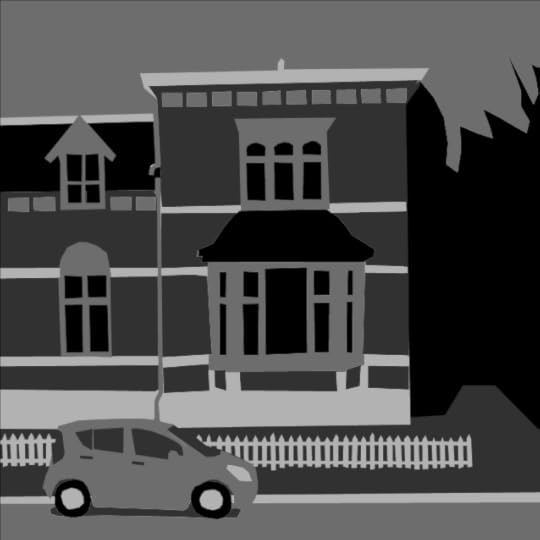
There are, of course, reasons why guns persist in videogames. Some actions translate better to the medium than others, and shooting is one of those actions. Bullets are also quantifiable, which is helpful insofar as game strategy is largely based on quantifiably scarce resources. Knives, on the other hand, are not suited for a world of ones and zeroes. You can’t neatly count down until a blade dulls. One of the challenges of being uncomfortable with the centrality of the gun in many games is that you aren’t just pushing back against cultural and political ideas; you’re also dealing with these wonkier factors.
The mechanical convenience of the gun does, however, seep into the more narrative realm. In games, as in real life, guns have become associated with agency. The person with the gun gets to decide how the story goes. We learn comparatively little about the lives of others. This distribution of agency, which frequently corresponds with the gap between protagonists and NPCs, gradually inures players to the human costs of their actions. Even though this doesn’t result in videogame players committing mass shootings by the dozen, there’s reason enough to be uncomfortable with cultural products that distribute agency in this manner or encourage the consumer of said products to think about agency along such terms.
For narrative and mechanical reasons, I don’t believe we should do away with guns in videogames. I do, however, wish that a greater effort was made to provide a measure of agency to characters other than the gun-wielding protagonist. First let deaths be meaningful, and then we can work from there. Although A Series of Gunshots is admirable in its intent, all agency still belongs to the shooter. He or she may feel guilt, but those who are shot remain invisible. In that respect, the game almost works more effectively as a piece of media criticism than it does as a corrective. You can feel as guilty as you want in this universe, and sometimes that just isn’t enough.
The story behind Downwell, one of this year’s most delightful surprises
Downwell might be a perfect game title. Not only is it short and pithy, but it serves as a perfect summation for what developer Ojiro Fumoto has created.
It’s a game in which a young boy is continuously falling down a well, avoiding enemies and purchasing upgrades along the way. But it’s not a hopeless endeavor. Armed with Gunboots firing from his feet, the boy is able to defend himself during his descent. The result is the type of sweat-inducing adventure that threatens to do water damage to your smartphone or controller, a game whose red and white character models and pixelated bursts pop boldly against a solid black background. Fumoto claims the idea for Downwell was borne from his obsession with the game Spelunky.
“I super love Spelunky, and there was a period where I couldn’t stop thinking about it wherever I went,” he says, recalling a particular moment when he pulled his phone out in a café. “I thought, ‘Whoa, okay … Wouldn’t it be awesome if there was a game like Spelunky playable on phones?’”
sweat-inducing adventure that threatens to do water damage to your smartphone
Known for its difficulty and randomized environments, Derek Yu’s Spelunky, from 2008, tasks players with exploring caves while fighting enemies and purchasing upgrades with the treasures they’ve found.
In its semi-completed state, Downwell is different from Spelunky. Still, Fumoto humbly posits the core ideas still remain inspired by the acclaimed game.
“[Downwell] ended up being a lot different from Spelunky, but I think I achieved my initial goal in that Downwell is a 2D platformer with (hopefully) tight controls and (hopefully) replay value,” he says.
It’s the so-called “Gunboots” that makes Downwell unique. Originally not included in an early prototype, these wacky accessories were created in an effort to simplify the control scheme of a touch screen mobile device.
“I intended to keep the number of buttons to [a] minimum, because I thought having more buttons would make the control a bit clumsy for mobile,” Fumoto says.
Working within this limitation, Fumoto started experimenting with ideas and eventually settled on the Gunboots, a contraption that fires a downward shot from the protagonist’s boots whenever the player hits jump.
Their unique application grabs attention. During development, Fumoto began sharing animated GIFs of Downwell on Twitter, showcasing its frantic personality to internet followers.
This eventually attracted the interest of Devolver Digital, the small publisher known for its stable of critically-acclaimed indie games like The Talos Principle and Hotline Miami.
Having the support of a publisher is no small victory for a developer. Especially for Fumoto, a relatively new member of the burgeoning Japanese indie development community.
the Japanese game industry has been slower to adopt the independent game movement
In the West, independent developers like Jonathon Blow and Mojang have become international superstars. But the Japanese game industry has been slower to adopt the independent game movement. Apart from big names like Castlevania’s Koji Igarashi and Mega Man’s Keiji Inafune, few Japanese developers have seen international success as independent game makers.
“There aren’t many full-time Japanese independent [developers] that I know of,” he says, cautious to speak too broadly based on his limited experience. “Most indie devs are working a separate job while they pursue this indie stuff in their spare time.”
He points to Nigoro and Studio Pixel as two exceptions, continuing to share his optimism about the future of Japanese indie development. Some things will have to change, he says, but that doesn’t mean there is no future for it in Japan.
“Indie games in general aren’t very well known or played among gamers in Japan, so younger people here aspiring to make games in the future tend to not even know that pursuing independent development for a living can be a thing. If indie games become more popular and widely known here, I think the scene really could start growing.”
With the release of Downwell and its subsequent acclaim, he’s continuing to forge through new territory in a relatively young market, unsure of what the future holds for Japan’s independent scene but persevering nonetheless.
Much like falling down a well.
Drift Stage’s soundtrack is being pressed onto a car-shaped vinyl
When Patrick McDermott of LA-based label Ghost Ramp first told me that two tracks from Drift Stage‘s soundtrack would be available on a car-shaped vinyl I didn’t fully grasp the idea. It’s to be a “shaped picture disc 7″ that’s the shape of one of the race cars from the game,” he said to me eagerly. Cool, I thought. That was it. I thought it was cool. But then I saw it and I realized the full implication of what he had originally told me. You can see the vinyl and its cover pictured above.
Yes, we’re talking about a vinyl that’s shaped like a race car. I know I’m repeating myself here but this is what it took for me to get my head around it. It’s not a circle shape as you’d typically expect of a vinyl disc. This one has corners. And it’s a car. A pixelly car with a lime-green bonnet and a tinted, dusk-red windscreen. Are those gold rims? I think they are. The most entertainment I’ve got out of this idea is to imagine placing the car-shaped disc in a record player and letting it spin. Would it even work? Would the needle fail to adapt to the disc’s rigid shape? I’m enjoying the suspense of not knowing the answer to that (I presume it will).
captures the energy of the game soundtracks during that era
The person responsible for the design of the vinyl, as well as its art work, is Charles Blanchard. “Why did we make it shaped like the car?” he asks himself. “To be honest, it’s only because we couldn’t make the vinyl an actual matchbox car that you can play on your record player.” Holy shit. Someone please make a vinyl that has a little race track in the grooves that you can let a toy car whiz around on while the record plays. Is this going too far?
Drift Stage Main Theme / Exclusive Coupé by MYRONE
Alright, let’s tone it down, I’ll put the six-year-old me back in his box. The reason for Drift Stage having this special vinyl disc is something that the musician, Hugh Myrone, neatly sums up. “Both Drift Stage the game as well as the music are modern takes on retro ideas,” he reasons, “so what better way to release the music than a crazy picture shaped vinyl?”. He’s right. If you don’t know, Drift Stage is a throwback to the arcade racers of the 1990s, which had none of the simulation-heavy focus of many racing games today, focusing instead (and purely) on speed, sunshine, and screeching tires. Myrone’s music, too, captures the energy of the game soundtracks during that era: loud, smiling pop-rock guitar riffs meant to be played on stage with big gestures and big hair, as well as deep, bouncy synth lines that cut through a night time drive illuminated by the commercial lights of a city.
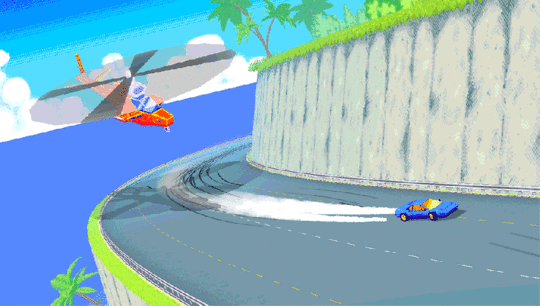
True enough, this retro-modern rehash is exactly what designer Blanchard saw in Drift Stage and its soundtrack; the old is new once again. Hence, releasing a vinyl now, when its most dominant years are now decades in the past, seemed an appropriate gesture. This idea extended to the vinyl’s art work, as Blanchard explains: “The original idea I had [for the art] was to make it resemble a RGB title screen, or a really old website on a CRT,” he says. Hence, it does.
The Drift Stage vinyl soundtrack is ready to pre-order right now. It should be ready to ship in mid-January 2016. “This 7″ is a lead up to a release of the entire OST on double LP vinyl,” adds McDermott, who clarifies that the full soundtrack will be out alongside the finished game. Plus, this is to be only the first game OST vinyl release for Ghost Ramp, as next the label will be turning its attention the soundtracks of Crypt of the NecroDancer and LISA the RPG.
Two grown men debate the merits of Justin Bieber and One Direction
In the battle of Bieber and One Direction, everyone wins.
Clayton Purdom (CP): David, defend One Direction.
David Rudin (DR): I’ll get to One Direction, I promise, but first I want to discuss Backstreet Boys and Take That, because no boy band really exists in a vacuum. We like to imagine them as such, much as we like to imagine that our parents never had sex apart from the time they conceived us. It’s nonsense, sure, but it’s nonsense as a rite of passage.
Consequently, my case for One Direction begins with the boy bands of my youth. This was a time when boy bands were big but no longer able to keep their inherent artifice under wrap. Backstreet Boys and *NSYNC both filed lawsuits against their manager, Lou Pearlman. That they shared a manager was a significant revelation, but it paled in comparison to the claim that Pearlman was getting paid as the sixth Backstreet Boy. (He was sentenced to 25 years in jail for unrelated financial shenanigans in 2008.) As these bands fell apart, they grew more interesting. They still possessed fantastic pop catalogues, but they now possessed interesting emotions, too. They were broken, not in a particularly romantic way, but rather by the vicissitudes of capitalism. The emotions and melodies of boy band songs don’t really have to match, but you do need both.
That brings us to One Direction, a boy band that exists as a direct response to the disintegration of the Backstreet Boys, *NYSNC, and Take That. Pieced together by the judges on the UK’s X Factor (a campy singing competition that exists mainly to serve as grist for the Daily Mail’s content mills), a certain amount of artifice is built into One Direction’s DNA. No, of course they aren’t lifelong friends, but they’ve become friends since meeting on the show. Sure. And management is built into the One Direction mythos: much of the wondrous fanfiction surrounding the band is based on the premise that Modest Management is preventing the boys from acting out their love for one another. One Direction isn’t exactly sentient, but they’re clawing their way out of the pop machine’s primordial ooze, and I find that interesting.
Since this is apparently a videogames site, I want to mention geometry. The best part of any boy band performance is how the members move in tight, geometrical formations like fighter jets, each taking their turns at the front. On a purely mechanical level, I find this profoundly satisfying.
It’s a lot like synchronized swimming: I don’t find it to be the pinnacle of artistic expression, but I find it interesting nonetheless. That’s basically how I feel about One Direction.
You’ll notice I have yet to mention singing, and that’s with good reason. One Direction can sing well enough. That’s about all that matters. There are a couple good ballads and pop song in their catalogue. Much like comic characters, boy bands are now vehicles for the creation of IP catalogues. The boys are not great singers, but they’ll be cashing in on these songs when they reunite in 15 years for a cruise or a tour. This aggressive adequacy is exactly what a boy band should be relied upon to provide.
Clayton, defend Justin Bieber.
CP: On the one hand, there is no defense of Justin Bieber. He is a self-evident asshole. His 2011 documentary Never Say Never, ostensibly recored during his innocent, under-18 phase, is a terrifying recording of a child grown power-sick, terrorizing his various employees with toys and faintly concealed intoxicants, and running rampant throughout the various chartered flights and airplane hangars that house him. This deposition, which I watch in its entirety several times per year, is remarkable not just for its sense of well-fed, “lawyers tryin’ to kill me” arrogance, but the way Bieber acts straight-up aggrieved about the fact that he is being questioned by a lawyer, a tendentiousness made palpable during his brief, showy display of fury when asked about one-time flame Selena Gomez. At one point he also just feigns falling asleep. His Instagram is almost exclusively pictures of him pouting at a sunset, intercut with videos of other people (paid employees) letting him cross them over on a basketball court. He is terrible at skateboarding but posts videos of barely landed nollies all the same.
But anyone who comes to a celebrity for moral virtuousness is mistaken. This is why we hate Gwyneth Paltrow and Bono; they pertain to _make us better_, and the response from the consuming populace is, generally, I’m good, go fuck yourself. We come to celebrity, rather, to enjoy some strange mix of disdain, avarice, and lust. There is plenty to disdain about Justin Bieber, certainly, and for those inclined to the private-jet lifestyle, or the little-boy-covered-in-tattoos look, he provides plenty for which to yearn. But my point is that this endless stream of hate-able News Content—the depositions and dick pics, the racist jokes and the hook-ups—actually qualifies as top-tier celebrity content, and that the other product, the music, is good, too. That’s one of the surprises of that documentary: the early viral footage of a baby Bieber as a musical prodigy, drum soloing as a 9-year-old and holding a room in thrall as a preteen. You realize, watching these videos, that those airplane hangars are his birthright, our cultural tribute to that mix of genetics that commingles once every decade or so and creates either a superstar or a flameout, or both. I’m not sure which Bieber is, and that’s part of what’s interesting about him.
And, anyway, that music: I am not about to ride hard in print for any Justin Bieber album, but his taste in singles is excellent, whether it’s his or Scooter Braun’s, the manager he shares with thinking-person’s pop-star Carly Rae Jepsen. “Baby,” which was written by The-Dream, would be a nightclub anthem if that artist had kept it for himself; “Where Are U Now,” with Diplo and Skrillex, is the best *NSYNC song since *NSYNC broke up; his latest single, “What Do You Mean?” has brought the panflute daringly back on the airwaves in an era when unironic saxophones are a cause celebre in indie circles.
David, what do you think of the new One-D album?
DR: I made a big mistake and listened to Made in the A.M. (The Deluxe Edition), which clocks in at an astonishing 17 tracks. This is six more tracks than any album needs and about 12 more tracks than this particular album needs. Let me also stipulate that this is a horrible name for an album. When you’re naming the thing after the last of a million bonus tracks, you know you’re in trouble. It may have been in the A.M. when I started with One Direction’s latest album, but it was definitely in the P.M. when I finished. Yes, that joke’s awful, but it’s the kind of joke this album deserved.
Okay, so that’s the preliminary sniping accounted for, but what about the album?
I posit that Made in the A.M. is perhaps the most-One Direction album ever. Not the best, but the most. In the absence of Zayn Malik, the band’s talented and/or brooding member, One Direction have resorted to effort as a substitute for musical skill. In this respect, they are the purest distillation of the adolescent typology boy bands are meant to represent; as anyone who has ever spent some time around a teenaged boy will tell you, this try-hard attitude is winning roughly 20% of the time. So it is with Made in the A.M., which opens well before wallowing in its own earnestness.
It all starts so promisingly. “Hey Angel” sounds like a forgotten Robbie Williams track from the late ‘90s, which is nothing to scoff at. The lyrics are complete nonsense—”I wish I could be more like you/Do you wish you could be more like me?” is not the question on which a good relationship is built—but the song is sufficiently enjoyable that I didn’t care. “Drag Me Down” and “Perfect” are both serviceable rock-inflected pop songs, if by “rock-inflected” one means “these guys really can’t dance so here are some guitars.” That is definitely what One Direction means, so I’ll stick with their definition.
Then come the ballads. So many ballads. Ballads of all shapes and sizes, so long as they are bloated. You have to hand it to One Direction: they really are trying. The decision to invest all of their energy into strained earnestness instead of peppy jaunts, however, has not paid off. One song bleeds into the next, each plaintively asking for love. I wanted to give the poor lads a prize for the effort so they’d just quit it already. Most boy bands suffer when the tempo slows, but One Direction absolutely disintegrates.
Made in the A.M. ultimately feels like a eulogy for One Direction’s teenage heartthrob phase. It starts off promisingly, before regressing to the sort of soporific balladry that the X Factor is known for. As I roused myself from an unplanned nap and listened to the album’s closing tracks, I could almost imagine the boys gracing a plinth on the X Factor’s dated set—there’s always a plinth—and singing these songs as contestants much more. Made in the A.M. isn’t a great way to go out, but at least it completes a narrative arc. Ashes to ashes, dust to dust, X Factor to Made in the A.M.
Clayton, what do you think of the new Bieber album?
CP: I mean, it’s fine. I have only been listening to the Deluxe version on Spotify, which is 19 tracks and frankly exhausting. If you’ve heard the singles, you’ve heard everything worth hearing. Most of the rest plies that secret middle-ground between adult contemporary and boy-band pop: endlessly breathy vocals, occasional soft hip-hop sex tracks, a frankly baroque approach to instrumentation. (That panflute on “What Do You Mean?” finds an analogue in acoustic guitars, vibes, auto-tune, etc.; every sonic element gets its own song, with little repetition.) The only real tonal difference between a new Bieber record and, say, one by Babyface is that Big Sean shows up for Bieb.
And, of course, there are those singles. “What Do You Mean,” “Sorry” and “Where Are U Now” are among the best pop songs released in the past year, a hot streak which begs the question of trajectory. An illustrative comparison might be drawn to Justin Timberlake, who similarly burst through the machinations of the music industry to become two of the rarest things in pop culture: 1) a likable celebrity, and 2) a pop star of clearly circumscribed aesthetic taste. Bieber will never be likable, and I see no indications that he favors a banger like “Where Are U Now” over the maudlin ballad that precedes it (literally called “Life Is Worth Living”) or the by-the-numbers inspirational EDM that follows it (literally called “Children”). Which is to say that he’ll always be in thrall to his producers, who will always be determined by market research, which means his absolute ceiling is, again, Usher, who bobs and weaves through eras with single after single, and even deep-album cuts that hit like singles; and that Bieber’s basement is probably closer to someone like Ne-Yo or even Chris Brown. And look: Ne-Yo’s had a career, and will be rich until he dies, but you don’t wanna be Ne-Yo, Justin Bieber. You definitely don’t wanna be Chris Brown.
In short, I remain cautiously optimistic.
David, it’s time for closing statements.
DR: Having listened to Purpose, I’m ready to concede your broader point about Bieber’s career trajectory. Although the album is even more of a snooze-fest than Made in the A.M., it suggests that my country’s most successful export has a bright future ahead of him. I can’t say that I know what Bieber’s “circumscribed aesthetic taste” really is at this point, but his albums are certainly cohesive and have progressed in a largely linear fashion. He can hang on for the foreseeable future if he so chooses.
The most interesting thing about Purpose, however, is that it is an exercise in low-grade televangelism. Although Bieber’s theological proclamations are not particularly deep, they are more than superficial allusions. He’s trying to get at something here, which is interesting even if it is largely an artistic failure. Bieber blends macro and micro crises of faith: the call for a lover to believe in him blends seamlessly into a call for faith in the future humanity. I’m not sure the ceiling to this approach is Usher, whose occasional bouts of shamelessness effectively combat maudlin urges, but just having an approach goes a long way.
One Direction, on the other hand, will always traffic in a lower form of spirituality. They don’t implore you to believe in any higher power; for as long as they perform, there is no higher power than teenage earnestness. I can’t say with certainty that I believe in God, but I’m willing to concede that His approach to faith is more sustainable than One Direction’s. All of which is to say that I am a heathen. One Direction’s short termism suits me better. I am not headed for a transcendental moment in a couple decades, but I will enjoy the hell out of the band’s inevitable reunion tour—or, even better, reunion cruise. In fact, One Direction are the kind of band who will be better in their reunion phase than in their nominal prime. The handful of good tracks on Made in the A.M. will sound lovely in a “greatest hits” set, which is more than I can say for their current context.
So Clayton, the final word is yours. What have you learned from this merry adventure of ours?
CP: I think you hit the nail on the head with the reunion tour concept. *NSYNC were better than Backstreet Boys at the time—remember the breathless press around their “more experimental” album Celebrity?—but I would rather hear “I Want it That Way” than “Pop” right now. The same is probably true of One Direction’s “Drag Me Down” versus Bieber’s “What Do You Mean?” So I think we’re both heathens: I’m rejecting a reunion tour in favor of what sounds good while I am drunk right now. (Not literally right now, but soon, probably.) I stipulate that I am over 30 years of age.
Purpose is frequently boring, but I am maybe more bored by Made in the A.M., despite the fact that it has a higher median song-quality. If I had to describe its sound in a word, that word would be “responsible.” It sounds an awful lot like Coldplay, front to back, with a slightly gooier, more motivational caramel center. Their ceiling is lower than Bieber’s—probably something like Hall & Oates—but their basement is already higher—Hanson, perhaps. I can imagine every one of Made in the A.M.’s 379 songs performed in a soccer stadium. This is a good type of music, and I am happy that it exists, though it is not for me. If I had to utter one hope for the boys of One Direction, in other words, it is that they all lead happy, productive lives hereafter, with moderately successful solo careers and an eventual world-conquering reunion tour. If I had to similarly hope for a single thing for Justin Bieber, it is that he begins using more club drugs.
Stay a while and be a good gardener
Sign up to receive each week’s Playlist e-mail here!
Also check out our full, interactive Playlist section.
A Good Gardener (PC, Mac, Linux)
IAN ENDSLEY AND CARTER LODWICK
Unlike games like Harvest Moon, A Good Gardener is not your grandma’s gardening game. Well, actually now that I think about it, the story of A Good Gardener might be most recognizable to someone like your grandmother. Set during WWII, the game puts the player in the role of someone planting a “victory garden,” which is the term the US government used to encourage citizens to join the war effort by growing their own food. In A Good Gardener, you are responsible for cultivating enough crops to satisfy the stuffy government supervisor. While most of the game consists of a relaxing daily routine, small design choices deepen the metagame. There’s never enough water, for instance, and you never get to enjoy the fruits of your labor. You raise each plant with all the love and care in the world, until The Man comes to take your baby away.
Perfect for: Grandmas, green thumbs, patriots
Playtime: A few hours
Fallout 4: Return to Junktown
For more in-depth game writing, back our Kickstarter!
Here comes the trashman! He’s strutting down the highway in his scrap metal suit, tin cans rattling up and down its legs, soda bottles and glue dispensers falling out the cracks between its plates, cereal boxes bobbling on the tips of his metal fingers. He’s blasting “The Wanderer” with no headphones on and waking the mole rats up. He’s bounding downtown like he owns the world. He intends to put all of it into his pockets.
He works fastest indoors: his vision jumps from floor to desk to shelf, hunting for the red ink of a vintage magazine cover or the yellow and blue markings of a bobblehead, which will sometimes alight next to a terminal like a rare warbler. Rarely finds them. He consoles himself by sweeping whole tables of junk into his trousers like a cartoon bank robber, loading up on TV trays and microscopes and circuit boards.
He carries almost three hundred and fifty-two pounds of garbage. He needs to stay high as a kite and blotto just to keep moving. When he gets hooked he turns to the miracle drug Addictol to straighten himself out. (Where does he stick the needle? Unknown: you hear only a pneumatic pssh!) You can’t get addicted to Addictol, but if you’re addicted to picking up trash it’s pretty much the same thing.
The sign of his passage is a bloody mess, a trail of pulped heads and innards
You couldn’t lock him up for acting like this—you’d have to lock up everybody. There’s a bit of trash-mania in all of his fellow Bostonians, who each keep a grab bag of drugs, 210-year-old processed food, and eccentric mementos on their person. Every raider seems to be on his way to a championship game of What Have I Got In My Pocket against Bilbo Baggins: this one has two guns and a baby rattle, that one a pool cue and a spatula. Mush-faced ghouls with radiation-pattern baldness carry hairbrushes. Even a regular Diamond City citizen like Earl Sterling keeps a human spinal column in his filing cabinet for no reason at all. The more powerful someone is, the more garbage they carry; that’s how the trashman knows he’s the baddest dude of all.
He is, you come to realize, not cleaning up but actually spreading trash. The sign of his passage is a bloody mess, a trail of pulped heads and innards scattered like fat red berries. And to this refuse he casually adds junk that has lost its appeal, hot plates and old shirts and pipe pistols, to make room for finer trash picked out from the gore. He can’t bear to leave the good stuff behind.
This last fact often brings on the great crisis of our hero’s life. When he runs out of booze and pills, he can barely crawl his way back to Bunker Hill. The weight of his collection roots him to the ground. This bouncing figure of fun, the trashman, now staggers into the market on gouty legs. Residents turn to watch the slow progress of the famous glutton, swollen and sick with the trash that he loves. (Their expressions remain frozen and impassive.) When at last he finds a merchant’s table or workbench to lean over, he releases a great torrent of all the junk that Boston could not digest: toasters and beakers, old gum and raw meat, moldy bills, rusty guns speared with nails, cartons of ancient cigarettes.
And as soon as he heaves out the last screw, the weight is lifted; the twinkle in his eye returns; the music starts up again; and he spins on his heel to return to the waiting world of trash.
///
One of the most ubiquitous items in The Elder Scrolls IV: Oblivion was a set of calipers. They were stuffed into unlockable containers, houses, and trolls’ bodies. Players couldn’t do anything with them. Merchants didn’t want them. They were “clutter items” that took up space and punished players who used the “Take All” button. The designers’ enthusiasm for them was mysterious.
In 2010, future Fallout 4 lead designer Todd Howard revealed to Official Xbox Magazine that the team had originally intended to add a quest that would tie the whole caliper thing together. “One of the guys pitched that you pick up calipers and take them to a swordsmith who makes you a sword called Excaliper,” Howard said, but this payoff was cut from the final game.
I’m not sure if this story was true or if it was Todd Howard true, but it suggests that even in 2006 there was a Patient Zero within Bethesda, someone carrying the idea that would infect and define Fallout 4: what if players had a reason to pick up every useless piece of junk in our game?
///
Fallout 4—or, as series fans will remember it, “the one with all the trash”—begins pre-apocalypse, in the shockingly clean Boston suburb of Sanctuary Hills. There’s a live-action cutscene about World War II, nukes, and war never changing that has almost no relevance to the story that follows. It actually seems like war has changed a lot since WWII, which was not about a junkie killing thousands of other people in order to take their glue.
what if players had a reason to pick up every useless piece of junk in our game?
We meet a wife and husband and their odd-looking child, and you can take the time to deform their faces as they peer into the bathroom mirror (sadly, the parents will not hold their baby up to the mirror and let you reshape him into Waluigi, or whoever). That’s about the only thing you have time to do in 2077 before air raid sirens go off and you’re pushed into a vault. Fallout 4 won’t delay the action long enough to give us a taste of the mundane, as games like Lost Planet 3 did—we don’t go to the block’s Halloween party or argue with a neighbor about the tree on the property line—and never sets up any of the sentiments about this period that the protagonist later expresses in dialogue. There is no emotional dimension to the old neighborhood, the old world; there’s no reason to miss it after our character is transported to the megafucked trashscape of the future. Suburbia doesn’t feel half as real here as Stanislaus Braun’s Twilight Zone simulation of it did in Fallout 3.
It’s no wonder Fallout 4 rushes toward the violence of the wasteland. The guns of the future include some real rock-and-rollers, and the search for new gun-scraps is irresistible. But the game’s approach to dialogue is a disaster. Never known for their polished scripts, Bethesda’s writers are now hobbled by a rigid four-option format in which each choice is expressed in three or four words at most. The menu is often as simple as “YES,” “NO,” “MAYBE,” or “[NOUN]?” In complex situations, the prompt may be as brief as “COMPROMISE,” leaving you to wonder which of a dozen conceivable solutions the protagonist will suggest. The thickets of dialogue in Obsidian’s Fallout: New Vegas, the quest branches that let you play both sides against the middle, the growth of old obligations around the player—it’s all been slashed and burned. In conversation, Fallout 4 is as simple as they come.
Before release, the internet was already jeering at a scene in which the protagonist is asked his opinion of “the news” and can reply “HATE NEWSPAPERS” or “SUPPORT NEWS.” The whole game talks like this. Late-period Bioware is the obvious model, but even those games dignify players with complete (short) sentences, and they occasionally splurge on two clauses. Here it feels like we’re stuck inside one of those low-intelligence playthroughs of Fallout 2.
The storytelling in Fallout 4 looks especially clumsy next to the work in Witcher 3, and I have serious questions for anyone who puts the former above the latter. Do you notice how in Fallout, people often carry on conversations without moving their lips, talk to you with their backs turned, talk to someone else while staring only at you, or speak while repeatedly waking up and falling asleep again—while those in The Witcher largely respect the conventions of human speech? Do you notice how almost every conversation in Fallout is filmed with the same static over-the-shoulder shots, sometimes cutting to the same awkward two-shot that isn’t framed correctly if the protagonist wears Power Armor—whereas those in The Witcher are full of tracking shots, long shots, and choreographed motion? Do you remember how The Witcher could get a laugh just from a character’s expression or gesture—whereas Fallout makes you wince at the stiffest animations in a major release this year?
But the real issue with Fallout 4’s dialogue isn’t the presentation but the response. In the original Fallout, mouthing off to NPCs could derail quests, start fights, and quickly send you to a mordant game over screen. You could talk your way into a raider stronghold and then decide to hit on the chieftain’s girlfriend, but the punchline wasn’t really what you said: it was the entire room of wired-up Khans attacking you. Fallout 4, by contrast, is barely listening. Most quests continue down the same path no matter how rude you are.
The pattern is set in the game’s prologue, when a Vault-Tec salesman asks for your signature and you can reply “NOT INTERESTED” then “NOT RIGHT NOW” then “GO AWAY” then “NO” then “I SAID NO.” Then your spouse walks up and signs it anyway. A surprising number of questgivers in Fallout 4 are salesmen at heart: they hear “no” as “tell me more.” It doesn’t matter how hard you try to burn your bridges with guys like Preston Garvey or Edward Deegan. They are unflappable.
You can dress up as whoever you want in Fallout 4, but you can only role-play as the trashman.
Speech checks (which now rely on the Charisma stat, and are easily gamed) rarely touch the narrative. They’re used more as a revenue stream than for emotional payoffs—like lockpicking or hacking, they funnel extra money and experience to the player. You coax more caps out of your employers by selecting MONEY then MORE MONEY then EVEN MORE MONEY. I was overjoyed the first time I found a speech option that wasn’t MONEY or FLIRT, but there are very few of them that actually save you time or open up a desirable quest branch. (It’s worst at the end of the game, when your options dwindle to “blow up these guys or blow up those guys,” and the “explain why this plan makes no sense” speech that should be there is not.) A second playthrough suffers, especially in comparison to New Vegas: here you talk to the same people, clean out the same factories for the same reasons, and pick up the same aluminum canisters on the way.
The lines that used to be checked against a Speech skill or stats like Perception, Intelligence, and Strength have been removed from Fallout 4, taking with them the moments that used to distinguish one RPG character from another. You can dress up as whoever you want in Fallout 4, but you can only role-play as the trashman.
///
But Fallout 4 does one thing so well that you can mostly forgive, if not ignore, its awkward treatment of the player character.
Bethesda’s team creates maps that are a joy to explore. They crash wooden ships into the tops of buildings, turn Walden Pond into a drug den, build a Chopping Mall-style galleria staffed by malfunctioning robots. It’s very hard to walk in a straight line through their world—you zig-zag between all the things you can’t resist checking out.
It’s the same thing Skyrim was sold on, of course. But the Commonwealth is better at keeping its promises, I think, than the province of infinite quests. It’s full of unmarked trails, sets of holotapes like the “Ladies Auxiliary” notes you find around Cambridge, and little handcrafted spaces like the Boylston Club, the site of a very exclusive group suicide. Even when charging through rooms on the hunt for fresh junk, these scenes bring you to a halt. The sheer number of stories embedded in locations feels like a conscious correction to Skyrim, which repeated itself to the point of discouraging explorers.
Bethesda’s team creates maps that are a joy to explore.
The game’s larger sidequests try their hand at every genre from H.P. Lovecraft homage (the Dunwich Borers pit, a nod to Point Lookout) to hard-boiled fetch quest (“Long Time Coming”), with mixed success. The kitchen sink approach is at its worst in “Confidence Man,” a Diamond City quest that follows a familiar sitcom plot without adding even a hint of Fallout personality. But it also leads to gems like “The Silver Shroud,” in which the player agrees to act out the increasingly bloody crime-fighting fantasies of a man who idolizes a pre-war, The Shadow-ish radio hero. I don’t think any other quest quite matches its absurd enthusiasm—“Last Voyage of the U.S.S. Constitution” comes close, but bad voice acting deflates it. Another good one, “Human Error,” hinges on a personality test that variously recalls Blade Runner, Ultima character creation, and (a wiki informs me) the test at the start of Fallout 3 that I always skip.
The game’s human characters are forgettable. But its honest robots, the goggling Mr. Handys and Gutsys and their fellow RobCo creations, are a pleasure to encounter. Stationed as bartenders, janitors, and tour guides, they’ve all decayed or prospered along with their surroundings. Some march out for charmingly stupid little demonstrations, like the Protectron Parade at Robotics Pioneer Park; others are permanent installations, like the bowler-clad bartender Whitechapel Charlie, who pays the protagonist’s fee while grumbling that it’s “a right kick in the Alberts.” There’s an addled machine that nearly murders you with a cup of coffee, and an armless Handy model that takes up a post as a ship’s bosun. Their voices—eternally peppy, deluded, marching happily toward disaster—are the game’s authentic comic spirit, one very different from the caustic tone of the original Fallout.
But even they are absent from the game’s best and loneliest story. You’ve got to head down to the desolate settlement of University Point to find it, and there’s no quest flag that I know of to lead you through. If not for a few wandering enemies, this section of the game would be a full-on walking sim: you wander through the pre-war college halls and student union, which more recently hosted a small community, which even more recently disappeared. From notes and terminals linked to the old university mailing system, you piece together a grim and surprisingly layered narrative: what happened to a father and his daughter, what happened to a professor before the war, and even what happened to a research assistant. This is what, on a good day, you find buried beneath all the post-apocalyptic junk: an honest-to-god story, plainly told and brutally effective. You also find a nice gun.
For more about Kill Screen’s ratings system and review policy, click here.
November 18, 2015
New Kickstarter uses crafting, jewelry, and games to get girls coding
A new Kickstarter entitled Giapetta’s Workshop wants to blend coding, crafting, and narrative into a single game that encourages 8-12 year old girls to be interested in STEM. The game begins in the real world, with a necklace and jewelry box that each girl can customize to fit her own style. The necklace then becomes her portal into an animated Adventure-Story app that turns learning how to code into a magical journey. The necklace serves as an input device which reveals hidden spells that, in turn, can only be unlocked by learning a basic coding program.
Giapetta’s Workshop stars a twelve-year-old named Giapetta Geraldine Ginger-Giles, who discovers a magical necklace that can transport her to different magical realms. When a sorceress named Corundum turns Gia’s mother into stone, it’s up to her to learn how to use the necklace. This is where the computer programming comes in: to overcome certain puzzle challenges she meets along the way, Giapetta must put the right kind of elements together in the right order to successfully cast a spell. Unlocking spells becomes a game of problem solving, as girls test out different solutions with different effects. Each spell they cast correctly is then added to the necklace so they can use it again in a different situation.
“coding can be a creative endeavor”
Though the creators and toy-makers behind the game want to focus on closing the wide gender game between girls and boys interested in STEM (science, technology, engineering and math), they also wanted to give value to the more traditionally “feminine” faculties as well. They incorporated strong elements of the arts into Giapetta’s Workshop because “we want kids to understand that coding can be a creative endeavor.” Which is why the puzzles in Giapetta’s Workshop emphasize “opportunities to be imaginative: to use code to create music, art and animation.” In the end, the team not only hopes to inspire girls into STEM, but also to push beyond that and start teaching kids through what they’ve termed “STEAM education.”
You can contribute to the Kickstarter here.
Kill Screen Magazine's Blog
- Kill Screen Magazine's profile
- 4 followers




